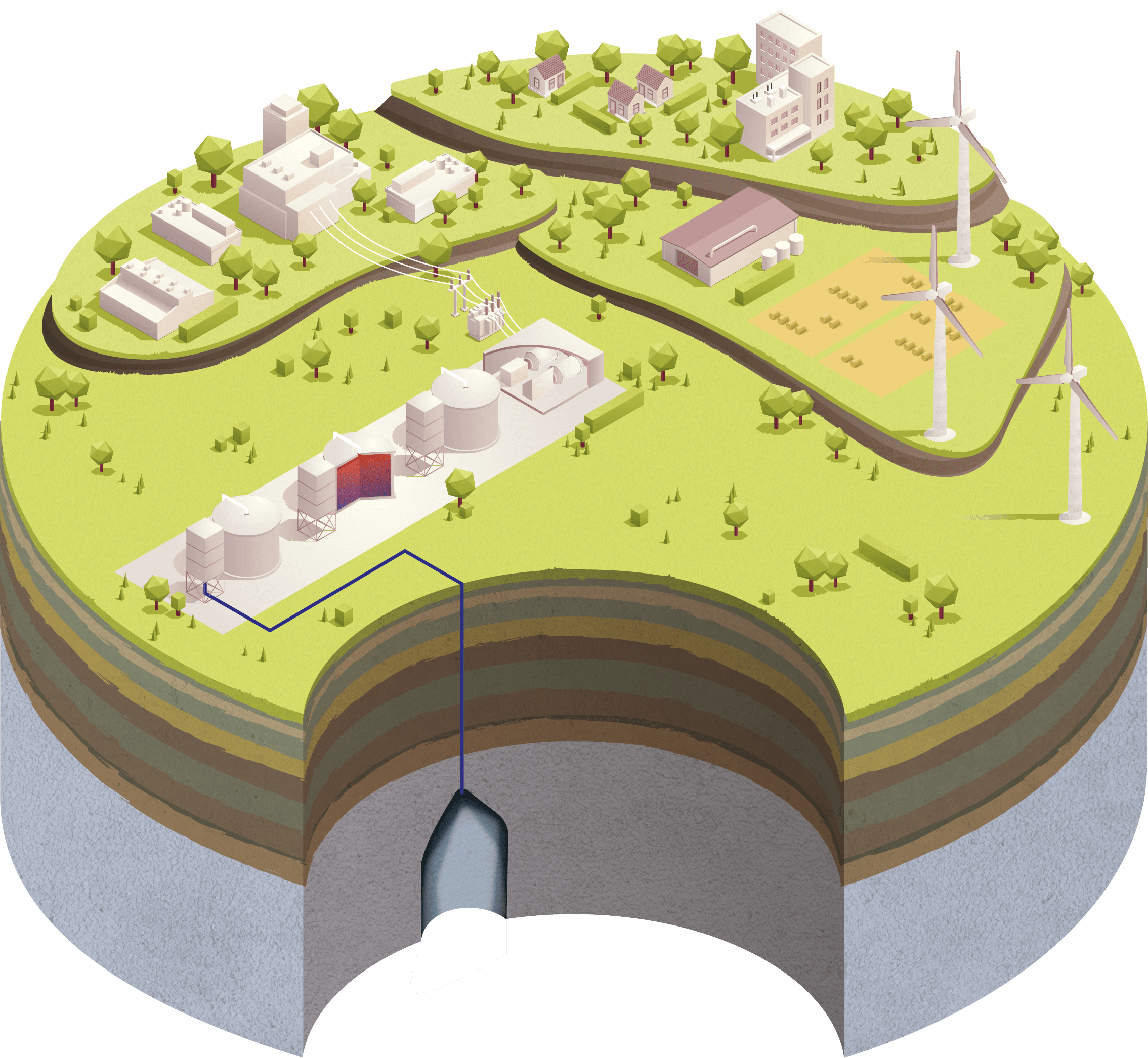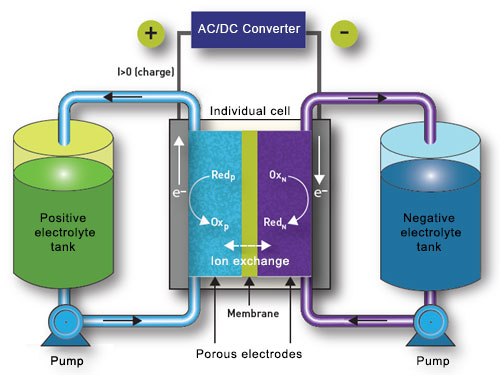 Energy storage
Energy storage
Our solutions
The energy transition will depend on a significant increase in the production of renewable electricity, particularly generated by wind farms and photovoltaic panels. The specific feature of these two technologies is that they depend on weather conditions, implying variable production that cannot be managed. Hence a potential lack of synchronization between electricity production and demand. In order to maximize the share of renewable energies in the energy mix, IFPEN proposes technological innovations for the integration of variable renewables in the networks, thereby supporting the development of technically and economically viable energy storage sectors.
Energy management systems
Energy storage can deliver a variety of services to the network (arbitrage or load management during peaks, for example): depending on their specific characteristics (investment and operating costs, yield, acceptable depth of discharge, etc), the various storage technologies vary in their suitability to meet these needs. IFPEN is developing a multicriteria analysis approach capable of identifying the best technical solutions in terms of their economic and environmental challenges. Its research activities incorporate the simulation of the system concerned throughout its life span and are hinged around the capacity to develop Energy Management Systems or EMS.
«An EMS is a system of computer-aided tools designed to optimize the performance of energy systems, applying strategies making it possible to fully exploit a storage system within a specific network. Such systems are of interest in contexts as diverse as:
- Smart Cities, where they operate on various levels (building, district, town/city). An EMS aggregates historic data and produces production and consumption forecasts in order to optimize storage and demand management (charging stations, for example). Combined with smart networks, an EMS enables the optimal management of complex situations,
- remote sites where it is necessary to manage a storage system to create an electricity network or support a fragile electricity network.
Our optimization, data science and system control expertise, combined with the performance of our testing facilities enable us to develop Energy Management Systems with a view to proposing three types of services:
- steer the integration of renewable energies and storage in electricity consumption and identify associated investments. Our objective is to propose project optimization methods and tools integrating electricity production options based on renewable energies, according to different electricity purchase/sale or self-consumption objective models. Our long-established battery modeling expertise enables us to incorporate storage battery aging into the calculations,
- foster the emergence and profitability of self-consumption or energy community projects. We are working on remote flexibility forecasting services and storage system management. To predict electricity consumption and production, we rely on historical data as well as the collection of metadata, and develop smart models (machine learning). Our microgrid equipment at our Lyon site enables us to test and validate our developments,
- access operational project data, process it, display flexibility margins, manage demand. The EMS-lab@ifpen platform ensures real-time monitoring of sites equipped with renewable self-consumption production facilities, storage systems, charging stations. Via a user account, forecasts relating to production and consumption of a group of buildings (residential, tertiary) are represented, as well as the benefit of management systems.
Philippe Pognant-Gros, EMS project manager, IFPEN
Advanced adiabatic compressed air energy storage (AA-CAES)
Compressed air energy storage has existed since 1978 (Huntorf power plant in Germany) in the form of enhanced gas plants with a maximum energy efficiency of 50%. In these old Compressed Air Energy Systems (CAES), the heat produced by compression is lost. A more sophisticated concept is Advanced Adiabatic Compressed Air Energy Storage (AA-CAES): this solution makes it possible to store compression heat and achieve a far higher degree of efficiency.

«Using the AA-CAES principle, we are developing a system:
- based on a maximum of off-the-shelf components, such as compressors and turbomachines,
- proposing innovative solutions, for components that do not yet exist, such as TES (Thermal Energy Storage) storage systems,
It operates as follows:
- storage is based on air compression and heat storage,
- air is passed through turbines following re-heating to release the energy from storage.
Storage is cavity-based, with this offering the advantage of being more efficient and cheaper than surface-based storage, which would require more substantial equipment.
We are focusing our developments on two aspects:
• The choice of efficient heat storage systems
• Process optimization
o improved management of heat transfers during air compression and expansion phases
o choice of pressure ranges
o use of innovative materials

David Teixeira, compressed air energy storage project manager, IFPEN
Electrochemical storage via Redox flow batteries
Electrochemical storage, particularly via Redox Flow Batteries, is suitable for applications requiring the storage of significant quantities of energy, especially since the large-scale roll-out of the solution makes considerable cost reductions possible.
Redox flow batteries are, in fact, rechargeable accumulators that have the capacity to store energy in the liquid phase:
- two liquid electrolytes containing electro-active species in solution circulate within the two positive and negative compartments of an electrochemical reactor, these compartments being separated by an ion-exchange membrane,
- the electrolytes are stored in tanks.

The main components of a flow battery are:
- stacks: individual cells are mechanically combined and electrically connected in series to achieve standard direct current voltages,
- electrolyte tanks,
- pumps and pipes necessary to enable the electrolytes to flow,
- the BMS (Battery management system),
- the DC/AC conversion system (PCS / Power conversion system)
«The specific characteristic of Redox battery technology lies in the separation, in terms of design, between:
- the power, governed by the active section of the electrodes and the membrane (reactor size) and by the circulating electrolyte flow (pump flow rate)
- and the quantity of energy stored, which depends on the quantity of electrolytes present in the tanks.
This technology thus offers unique modularity, since the batteries can be scaled to the desired power and energy and thus be adapted for use in a large number of applications. However, the relatively low energy density of the electrolytes does represent an important drawback: the preferred fields of application for these batteries thus lie in the intermediate power ranges from around 10 kW to several MW, and storage times of between two and ten hours.
To facilitate the roll-out of the technology, our research activities are aimed at:
- developing new materials (electrolytes), cheaper and more efficient than existing ones, such as vanadium, notably by developing systems based on water-soluble organic molecules
- optimizing system management using multi-physical and multi-scale modeling
- understanding elementary mechanisms (electrochemical reactions, matter transfer) via multi-scale characterization (laboratory, pilot and demonstrator) and use of online analysis systems .»
David Pasquier, Energy Storage project manager, IFPEN
Watch a video on Redox flow batteries with David Pasquier, project manager, IFPEN (in French):








